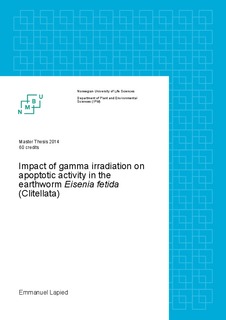| dc.description.abstract | Earthworms are organisms of key importance worldwide. As ecosystem engineers, they
constitute one of the main structuring agents of most soil ecosystems. Previous studies have
concluded that earthworms appear to be among the most radiosensitive component of the soil
fauna, and decreases in populations have been observed following accidents. Radiosensitivity
varies with the developmental stage, with immatures being more radiosensitive than adults.
However, little is known about the mechanisms of radiation impact on earthworms. At the
ultrastructural scale and as organisms living in close contact with soil, earthworms developed
efficient immune and apoptotic systems. This mainly caspase- and mitochondria-dependent
system controls and regulates cell proliferation and elimination of damaged cells. Since
apoptosis is known to be a central mechanism in the biological response to irradiation, better
understanding of this cell process after radiation exposure is of first interest.
The aim of this work is to shed a new light on potential impacts of low total doses of ionizing
gamma radiations on the apoptotic activity in earthworms and on their physiological capacity
to withstand a certain level of irradiation. The study design was based on irradiation of the
earthworm species Eisenia fetida during 7 days at 0, 0.14 and 10 mGy.h-1, this level of exposure
being known to reduce the cocoon hatchability, and at 10°C and 20°C to investigate any impact
of temperature. Three different apoptosis methods (TUNEL, Apostain and caspase 3 staining)
were tested on five different tissues: cuticule, circular and longitudinal musculatures, intestinal
epithelium and chloragogenous matrix.
Our results confirmed the applicability of apoptosis as a useful and reliable biomarker for
radiation impacts on earthworms. The three different staining methods gave comparable
results although some statistically significant differences seem to indicate that caspase 3
labeling could have a better detection limit. Three major results were obtained: 1) within a
given tissue, an exposure to 10 mGy.h-1 of external γ-radiation always led to an increase of the
number of apoptotic cells comparing to the controls; 2) in all groups, the intestinal epithelium
and chloragogenous matrix showed a higher level of apoptosis (up to six times higher)
compared to the other tissue types; and 3) the temperature (10°C and 20°C) had probably low
or no effects on the apoptotic signal. The result tends to show that, after only 7 days of exposure at a dose-rate known to reduce the
cocoon hatchability (albeit at longer times and higher total doses), ionizing radiations trigger an
apoptotic response in tissues constituting the major part of the animal body. This means that
the biomarker may be a useful early indicator of potential negative effects, given that the dose
rates are known to result in negative impacts at the organism level. In addition, such a level of
programmed cell death in the intestinal and chloragog cells may have heavy consequences for
the earthworms. The intestinal epithelium plays a central role in the absorption of nutrients,
while the chloragogenous tissue, covering the external pared of the intestine, is a crucial organ
in the ionic balance and the immune system. Potential damages or over-stimulation of the
apoptosis after irradiation might dramatically affect crucial physiological processes controlled
by these structures. Moreover, their localization at the interface between interior and exterior
medium may explain their high reactivity comparing to the other tissues.
In spite of comparable results between the three tested methods, differences are notable.
Thus, a lower apoptotic activity was revealed by caspase 3 labeling, for almost all treatments,
with only high levels being seen in the longitudinal musculature at 10°C and 10 mGy.h-1. In
addition, the caspase 3 labeling method was the only one that showed a statistically significant
increase at only 0.14 mGy.h-1. The more sensitive detection limit could reflect the relatively low
level of background apoptosis in controls compared to the other treatments. Hence a
combination of at least carpase 3 labelling and TUNEL or Apostain would be recommended for
studies on this mechanism in earthworms.
This study constitutes one of the very first report and description of the apoptotic process in
earthworms and, after antibody labeling, represents a pioneer work in showing the
conservation of caspase 3 proteins in earthworms. This latest result is of high interest
considering the central role of caspase 3 in the control of the apoptotic cascade in particular as
a molecule regulated by mitochondria through the release of cytochrome c. In addition, the
results obtained in this work could be relevant in our understanding of potential links between
apoptosis and radiosensitivity. | nb_NO |
